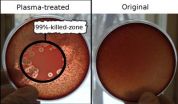Body fat distribution associated with a higher risk of ER-negative breast cancer
2010-12-16
(Press-News.org) Body fat distribution does not play an important role in the incidence of every subtype of premenopausal breast cancer, but is associated with an increased risk for estrogen receptor (ER)–negative breast cancer, according to a study published December 15 in The Journal of the National Cancer Institute.
Previous studies have shown that the association between body mass index (BMI) and the risk of breast cancer varies with menopausal status: a higher BMI is positively associated with risk of postmenopausal breast cancer but inversely associated with risk of premenopausal breast cancer. Intra-abdominal fat that surrounds organs has been associated with metabolic and hormonal changes that have been associated with premenopausal breast cancer risk, although prospective studies have produced conflicting results, and none have examined the role of hormone receptor status.
To determine the relation between body fat distribution and premenopausal breast cancer risk, Holly R. Harris, Sc.D., of Brigham and Women's Hospital and Harvard Medical School in Boston, and colleagues, conducted a prospective analysis among women in the Nurses' Health Study II, a cohort of 116,430 women who have been followed up since 1989. In 1993 the researchers sent women in that study a questionnaire in which the women were asked to measure and report their waist and hip circumference.
The researchers found no statistically significant associations between waist circumference, hip circumference, or the waist to hip ratio and overall risk of breast cancer. But they did find that abdominal adiposity, or waist circumference and the waist to hip ratio, was more strongly associated with risk of ER-negative breast cancer than with the risk of ER-positive breast cancer.
Furthermore, the fact that body fat distribution was more strongly associated with ER-negative breast cancer than with ER-positive breast cancer suggests that body fat may influence breast cancer risk through sex hormone–independent pathways. Specifically, the researchers note that abdominal fat is associated with hyperinsulinemia, or pre-diabetes, and that insulin receptors are expressed in most breast cancers and have been shown to stimulate the growth of breast cancer cells in vitro.
"These findings may suggest that an insulin-related pathway of abdominal adiposity is involved in the etiology of premenopausal breast cancer," the authors write.
INFORMATION:
Contact:
Media relations contact: Holly Brown-Ayers, hbrown-ayers@partners.org
ELSE PRESS RELEASES FROM THIS DATE:
2010-12-16
"Staph" bacteria feed on blood. They need the iron that's hidden away inside red blood cells to grow and cause infections. It turns out that these microbial vampires prefer the taste of human blood, Vanderbilt University scientists have discovered.
The researchers report in the Dec. 16 issue of Cell Host & Microbe that Staphylococcus aureus (staph) favors human hemoglobin – the oxygen-carrying protein that contains iron – over hemoglobin from other animals. The findings help explain why staph preferentially infects people and suggest that genetic variations in hemoglobin ...
2010-12-16
STANFORD, Calif. — More than 2,000 genetic regions involved in early human development have been identified by researchers at the Stanford University School of Medicine. The regions, called enhancers, are responsible for triggering the expression of distant genes when embryonic stem cells begin to divide to form the many tissues of a growing embryo.
"This is going to be an enormous resource for researchers interested in tracking cells involved in early human development," said Joanna Wysocka, PhD, assistant professor of developmental biology and of chemical and systems ...
2010-12-16
LA JOLLA, CA-In addition to fast food, desk jobs, and inertia, there is one more thing to blame for unwanted pounds-our genome, which has apparently not caught up with the fact that we no longer live in the Stone Age.
That is one conclusion drawn by researchers at the Salk Institute for Biological Studies, who recently showed that mice lacking a gene regulating energy balance are protected from weight gain, even on a high fat diet. These findings have implications for the worldwide obesity epidemic and its consequences, such as type two diabetes.
In the December 16, ...
2010-12-16
The software tool presents data visually and this allows those without specialist training – both professionals and older people – to better understand and contribute to discussions about the mechanics of movement, known as biomechanics, when carrying out everyday activities.
The software takes motion capture data and muscle strength measurements from older people undertaking everyday activities. The software then generates a 3D animated human stick figure on which the biomechanical demands of the activities are represented visually at the joints. These demands, or stresses, ...
2010-12-16
A newly published insight into the biology of many kinds of less-aggressive but still lethal brain tumors, or gliomas, opens up a wide array of possibilities for new therapies, according to scientists at Brown University and the University of California, San Francisco (UCSF). In paper published online Dec. 15 in the Journal of the National Cancer Institute, they describe how a genetic mutation leads to an abnormal metabolic process in the tumors that could be targeted by drug makers.
"What this tells you is that there are some forms of tumors with a fundamentally altered ...
2010-12-16
Richmond, Va. (Dec. 15, 2010) – Researchers at Virginia Commonwealth University Massey Cancer Center and the VCU Institute of Molecular Medicine (VIMM) have developed a novel virus-based gene therapy for renal cell carcinoma that has been shown to kill cancer cells not only at the primary tumor site but also in distant tumors not directly infected by the virus. Renal cell carcinoma is the most common form of kidney cancer in adults and currently there is no effective treatment for the disease once it has spread outside of the kidney.
The study, published in the journal ...
2010-12-16
Absence makes your heart grow fonder, but close-quarters may boost your career.
According to new research by scientists at Harvard Medical School, the physical proximity of researchers, especially between the first and last author on published papers, strongly correlates with the impact of their work.
"Despite all of the profound advances in information technology, such as video conferencing, we found that physical proximity still matters for research productivity and impact," says Isaac Kohane, the Lawrence J. Henderson Professor of Pediatrics at Children's Hospital ...
2010-12-16
A small-scale University of California, San Francisco-led study has identified the first evidence in humans that exposure to bisphenol A (BPA) may compromise the quality of a woman's eggs retrieved for in vitro fertilization (IVF). As blood levels of BPA in the women studied doubled, the percentage of eggs that fertilized normally declined by 50 percent, according to the research team.
The chemical BPA, which makes plastic hard and clear, has been used in many consumer products such as reusable water bottles. It also is found in epoxy resins, which form a protective ...
2010-12-16
Cold plasma jets could be a safe, effective alternative to antibiotics to treat multi-drug resistant infections, says a study published this week in the January issue of the Journal of Medical Microbiology.
The team of Russian and German researchers showed that a ten-minute treatment with low-temperature plasma was not only able to kill drug-resistant bacteria causing wound infections in rats but also increased the rate of wound healing. The findings suggest that cold plasmas might be a promising method to treat chronic wound infections where other approaches fail.
The ...
2010-12-16
15 December 2010, MDMA or 'ecstasy' increases feelings of empathy and social connection. These 'empathogenic' effects suggest that MDMA might be useful to enhance the psychotherapy of people who struggle to feel connected to others, as may occur in association with autism, schizophrenia, or antisocial personality disorder.
However, these effects have been difficult to measure objectively, and there has been limited research in humans. Now, University of Chicago researchers, funded by the National Institute on Drug Abuse, are reporting their new findings in healthy volunteers ...
LAST 30 PRESS RELEASES:
[Press-News.org] Body fat distribution associated with a higher risk of ER-negative breast cancer


